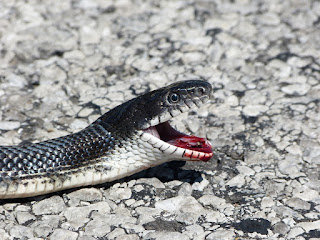I went back to the site daily until I confirmed it as a Tiger Spiketail on July 29th, and captured and photographed one on July 30th. I was pretty excited to say the least - a new record for Canada. Also encouraging was that I saw both a male and female in the area so I was pretty sure there was a small breeding population in the area.
I've checked this site several times this year hoping to prove there is a breeding colony here but hadn't found anything until today. This isn't surprising given that they fly later than our other spiketails, with July being the main month they fly in Ohio. Today I had just about given up hope when a male Tiger Spiketail appeared just a few feet in front of me, buzzing around some leaves and twigs, and not perching very often. I managed one "decent" photo before he disappeared. It will be interesting to check the site in early and mid-July to see if I can find more than just 1 or 2 individuals. It would be even better if I could find them at another location nearby.
This is the individual from today, seen briefly on June 26, 2012.
The photos below are from a male I found last year.
.
Today I also found my first Comet Darner, and presumeably one of few if any for Norfolk County. This is a rare migrant as far as I know, but could and may breed in Ontario as well. I had brief looks at it as it flew along a forest edge, presumeably hunting. It appeared to be on the move and wasn't sticking around. It's bright red abdomen was distictive with the naked eye.
I also photographed (poorly) a Painted Skimmer today which was nice since I thought I had one earlier in June and another one on Saturday closer to Port Burwell. This is another uncommon migratory dragonfly that comes north in summer.
Edward's Hairstreaks were abundant today, nectaring on New Jersery Tea and Butterfly Milkweed. A few Coral Hairstreaks were mixed in, and lots of Silvery Checkerspots as well. One got caught by a yellow crab spider.
Edward's Hairstreaks (above and below)
Coral Hairstreak
Camouflaged spider making a meal of a Silvery Checkerspot
I hope these Barn Swallow chicks fledge soon, my front stoop needs a good cleaning and I'm tired of getting dive bombed by the parents every time I leave the house.



















































